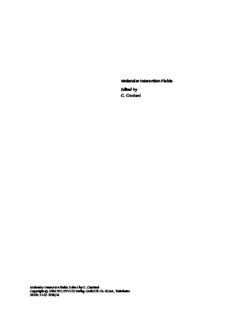
Molecular Interaction Fields: Applications in Drug Discovery and ADME Prediction, Volume 27 PDF
Preview Molecular Interaction Fields: Applications in Drug Discovery and ADME Prediction, Volume 27
MolecularInteractionFields Editedby G.Cruciani MolecularInteractionFields.EditedbyG.Cruciani Copyright(cid:1)2006WILEY-VCHVerlagGmbH&Co.KGaA,Weinheim ISBN:3-527-31087-8 Related Titles Methods and Principles inMedicinal Chemistry EditedbyR.Mannold,H.Kubinyi,G.Folkers EditorialBoard H.-D.H(cid:1)ltje,H.Timmermann,J.Vacca,H.vandeWaterbeemd,T.Wieland Previous Volumes ofthis Series: O.Zerbe(ed.) H.Kubinyi,G.M(cid:3)ller(eds.) BioNMR in DrugResearch Chemogenomics in DrugDiscovery Vol.16 Vol.22 2002,ISBN3-527-30465-7 2004,ISBN3-527-30987-X P.Arloni,F.Alber(eds.) T.I.Oprea(ed.) QuantumMedicinal Chemistry Chemoinformatics in Drug Vol.17 Discovery Vol.23 2003,ISBN3-527-30456-8 2004,ISBN3-527-30753-2 H.vandeWaterbeemd,H.Lennern(cid:2)s, P.Artursson(eds.) R.Seifert,T.Wieland(eds.) Drug Bioavailability G Protein-Coupled Receptors Vol.18 as DrugDiscovery Vol.24 2003,ISBN3-527-30438-X 2005,ISBN3-527-30819-9 H.-J.B(cid:1)hm,S.S.Abdel-Meguid(eds.) Protein Crystallography O.Kappe,A.Stadler in Drug Discovery Microwaves in Organicand Vol.20 Medicinal Chemistry Vol.25 2004,ISBN3-527-30678-1 2005,ISBN3-527-31210-2 Th.Dingermann,D.Steinhilber,G.Folkers(eds.) MolecularBiology in Medicinal Chemistry Vol.21 2004,ISBN3-527-30431-2 Molecular Interaction Fields Applications in Drug Discovery and ADME Prediction Edited by Gabriele Cruciani SeriesEditors & AllbookspublishedbyWiley-VCHare carefullyproduced.Nevertheless,authors, Prof.Dr.RaimundMannhold editors,andpublisherdonotwarrantthe BiomedicalResearchCenter informationcontainedinthesebooks, MolecularDrugResearchGroup includingthisbook,tobefreeoferrors. Heinrich-Heine-Universit(cid:2)t Readersareadvisedtokeepinmindthat Universt(cid:2)tsstrasse1 statements,data,illustrations,procedural 40225D(cid:3)sseldorf detailsorotheritemsmayinadvertently Germany beinaccurate. [email protected] LibraryofCongressCardNo.:appliedfor Prof.Dr.HugoKubinyi BritishLibraryCataloguing-in-PublicationData Donnersbergstrasse9 Acataloguerecordforthisbookisavailable 67256WeisenheimamSand fromtheBritishLibrary. Germany [email protected] Bibliographicinformationpublishedby Prof.Dr.GerdFolkers DieDeutscheBibliothek DieDeutscheBibliothekliststhispublication CollegiumHelveticum STW/ETHZ(cid:3)rich intheDeutscheNationalbibliografie;detailed 8092Z(cid:3)rich bibliographicdataisavailableintheInternetat Switzerland <http://dnb.ddb.de>. [email protected] (cid:1)2006WILEY-VCHVerlagGmbH&Co.KGaA, Weinheim VolumeEditor Allrightsreserved(includingthoseof translationintootherlanguages). Prof.Dr.GabrieleCruciani Nopartofthisbookmaybereproduced UniversityofPerugia inanyform–nortransmittedortranslated DepartmentofChemistry intomachinelanguagewithoutwritten 06124Perugia permissionfromthepublishers.Registered Italy names,trademarks,etc.usedinthisbook, [email protected] evenwhennotspecificallymarkedassuch, arenottobeconsideredunprotectedbylaw. PrintedintheFederalRepublicofGermany. Printedonacid-freepaper. Composition K(cid:3)hn&Weyh,SatzundMedien, Freiburg Printing betz-druckGmbH,Darmstadt Bookbinding J.Sch(cid:2)fferGmbHi.G.,Gr(cid:3)nstadt ISBN-13: 978-3-527-31087-6 ISBN-10: 3-527-31087-8 V A Personal Foreword I was a young organic chemist when I met Prof. Sergio Clementi, but from the very first moment I understood that his guide to the world of Chemometrics would have been a brainwashing for me. And indeed it was so. Sergio was a splendid teacher and what I know in the field of QSAR and Chemometrics is totallyduetohim. From Sergio I learned the correct ways to produce mathematical models, and the tricks to interpret them. However, it was immediately clear that Chemo- metrics (and cheminformatics as well) can do very little when the numerical descriptorsarepoorornotrelatedtothephenomenaunderstudy. FewyearslaterIhadanotherbrainwashingwhenImetprof.PeterGoodfordat the European Symposium on QSAR in Sorrento (Italy). I was fascinated by his presentation and science, and I decided to learn more about. I spent in Oxford oneyearandPeterwasasecondscientificfatherforme.Itwasfantastictocom- plete my background working side by side with a scientist who did so much in thefieldofStructure-BasedDrugDesign.AllIknowonforce-fieldsandnumeri- cal descriptions of complex phenomena such as (macro)molecular interactions isduetohim.FromthatmomentIneverstoppedtousehissoftwareGRID. When ADME-attritions rate was large and in silico ADME procedures were stillunknown,IwenttoLausannetolearnpharmacokinetics workingwith Prof. BernardTesta.Againanotherimportantmaninmyscientificlife.Bernardpushed me deeply in the field of pharmacokinetics, and I was surprised to see how well PeterGoodford’sGRIDwasworkinginsuchadifferentfield. Myscientificcareerwasguidedandcomplementedbythesescientists,andthe reasonswhymyinterestsaresosparsedependontheirenthusiasmandimprint- ing. However, one thing I have always used in all the problems I have encoun- tered, or in all the procedure I developed. I have always used Molecular Interac- tionFieldstodescribethestructuresofchemicalandbiologicalsystems.Afterso mayyearsofwork,I’mstillfascinatedbytheamountofinformationtheycontain. Oneneverfinishestofindnewwaystoextractinformationfromthem.Moreover, combiningMIFwithchemometrictools,isapowerfulapproachtoallthefieldsof computerassisteddrugdevelopment. This led to the production of different algorithms, all reported in this volume andallbasedonPeter’sGRIDforcefield.ItisnoteworthythatGRID-MIFarecur- MolecularInteractionFields.EditedbyG.Cruciani Copyright(cid:1)2006WILEY-VCHVerlagGmbH&Co.KGaA,Weinheim ISBN:3-527-31087-8 VI APersonalForeword rently applied in structure based, pharmacodynamic and pharmacokinetic fields, aswellasinmetabolism.Anotherproof,(althoughnotnecessary)oftheversatili- ty,flexibilityandcorrectbio-parameterisationofPeter’sGRIDforcefield. ThisvolumereportstheMIFtheory,andseveralapplicationsofMIFsindiffer- entarenaofthedrugdiscoveryprocess.MIFsaredecodingthecommonlanguage of the (macro)molecules, the molecular interaction potential. Using MIF is sim- ple,interpretingthemstraightforward. It was a privilege to work on this volume with such a distinguished group of contributors,andI’msurethatthisvolumewillopenawindowonthefascinating worldofMolecularInteractionFields. Finally, I want to acknowledge my coworkers at Perugia University, and Prof. Raimund Mannhold and Prof. Hugo Kubinyi for their help, contribution and encouragementtoproducethisbook. Perugia,June2005 GabrieleCruciani VII Contents APersonalForeword V Preface XIV ListofContributors XVI I Introduction 1 1 TheBasicPrinciplesofGRID 3 PeterGoodford 1.1 Introduction 3 1.2 PhilosophyandObjectives 3 1.3 Priorities 4 1.4 TheGRIDMethod 5 1.4.1 GRIDProbesAreAnisometric 6 1.4.2 TheTarget“Responds”totheProbe 8 1.4.3 TheTargetisImmersedinWater 10 1.5 TheGRIDForceField 10 1.5.1 TheLennard-JonesTerm 11 1.5.2 TheElectrostaticTerm 11 1.5.3 TheHydrogenBondTerm 12 1.5.4 TheOtherTerms 12 1.6 Nomenclature 14 1.6.1 “ATOM”Records 14 1.6.2 “HETATM”Records 15 1.7 CalibratingtheGRIDForceField 16 1.7.1 CheckingtheCalibration 17 1.7.2 CheckingDatafileGRUB 17 1.8 TheOutputfromGRID 18 1.8.1 GRIDMapsfromMacromolecules 19 1.8.2 GRIDMapsfromaSmallMolecule 24 1.9 Conclusions 25 MolecularInteractionFields.EditedbyG.Cruciani Copyright(cid:1)2006WILEY-VCHVerlagGmbH&Co.KGaA,Weinheim ISBN:3-527-31087-8 VIII Contents 2 CalculationandApplicationofMolecularInteractionFields 27 RebeccaC.Wade 2.1 Introduction 27 2.2 CalculationofMIFs 27 2.2.1 TheTarget 27 2.2.2 TheProbe 28 2.2.3 TheInteractionFunction 29 2.2.3.1 VanderWaalsInteractions 29 2.2.3.2 ElectrostaticInteractions 30 2.2.3.3 HydrogenBonds 31 2.2.3.4 Entropy 32 2.3 SelectedApplicationsofMIFs 33 2.3.1 MappingaLigandBindingSiteinaProtein 33 2.3.2 Deriving3D-QSARs 34 2.3.3 SimilarityAnalysisofaSetofRelatedMolecules 36 2.4 ConcludingRemarksandOutlook 38 II Pharmacodynamics 43 3 ProteinSelectivityStudiesUsingGRID-MIFs 45 ThomasFox 3.1 Introduction 45 3.2 GRIDCalculationsandChemometricAnalysis 46 3.2.1 SourceandSelectionofTargetStructures 46 3.2.2 SelectionandSuperimpositionofBindingSites 47 3.2.3 CalculationoftheMolecularInteractionField 47 3.2.4 MatrixGenerationandPretreatments 50 3.2.4.1 RegionCut-outs 51 3.2.5 GRID/PCA 51 3.2.5.1 ScorePlots 52 3.2.5.2 Two-DimensionalLoadingPlots 53 3.2.5.3 LoadingContourMaps 54 3.2.5.4 ProblemsofGRID/PCA 54 3.2.6 GRID/CPCA 55 3.2.6.1 BlockUnscaledWeights 56 3.2.6.2 CPCA 58 3.2.6.3 IdentificationofImportantVariableBlocksforSelectivity 59 3.2.6.4 ContourPlots 59 3.3 Applications 60 3.3.1 DNAMinorGrooveBinding–CompareAAAandGGGDouble Helix 60 3.3.2 DihydrofolateReductase 61 3.3.3 Cyclooxygenase 61 3.3.4 PenicillinAcylase 62 Contents IX 3.3.5 SerineProteases 63 3.3.5.1 S1Pocket 64 3.3.5.2 PPocket 64 3.3.5.3 DPocket 66 3.3.6 CYP450 67 3.3.7 TargetFamilyLandscapesofProteinKinases 69 3.3.8 MatrixMetalloproteinases(MMPs) 70 3.3.9 NitricOxideSynthases 74 3.3.10 PPARs 75 3.3.11 BileAcidTransportationSystem 75 3.3.12 EphrinLigandsandEphKinases 76 3.4 DiscussionandConclusion 77 4 FLAP:4-PointPharmacophoreFingerprintsfromGRID 83 FrancescaPerruccio,JonathanS.Mason,SimoneSciabola, andMassimoBaroni 4.1 Introduction 84 4.1.1 PharmacophoresandPharmacophoreFingerprints 84 4.1.2 FLAP 86 4.2 FLAPTheory 86 4.3 Docking 88 4.3.1 GLUE:ANewDockingProgramBasedonPharmacophores 89 4.3.2 CaseStudy 91 4.4 StructureBasedVirtualScreening(SBVS) 92 4.5 LigandBasedVirtualScreening(LBVS) 94 4.6 ProteinSimilarity 95 4.7 TOPP(TripletsofPharmacophoricPoints) 97 4.8 Conclusions 101 5 TheComplexityofMolecularInteraction:MolecularShape FingerprintsbythePathFinderApproach 103 IainMcLay,MikeHann,EmanueleCarosati,GabrieleCruciani, andMassimoBaroni 5.1 Introduction 103 5.2 Background 104 5.3 ThePathFinderApproach 105 5.3.1 PathsfromPositiveMIF 105 5.3.2 PathsfromNegativeMIF 107 5.4 Examples 109 5.4.1 3D-QSAR 109 5.4.2 CYPComparison 112 5.4.3 Target–LigandComplexes 112 5.5 Conclusions 115 X Contents 6 Alignment-independentDescriptorsfromMolecularInteractionFields 117 ManuelPastor 6.1 Introduction 117 6.1.1 TheNeedforMIF-derivedAlignment-independentDescriptors 117 6.1.2 GRINDApplications 119 6.2 GRIND 120 6.2.1 TheBasicIdea 120 6.2.1.1 ComputationofMIF 121 6.2.1.2 ExtractionofHighlyRelevantRegions 122 6.2.1.3 MACC2Encoding 124 6.2.2 TheAnalysisofGRINDVariables 128 6.3 HowtoInterpretaGRIND-based3DQSARModel 130 6.3.1 Overview 130 6.3.2 InterpretingCorrelograms 131 6.3.3 InterpretingSingleVariables 133 6.3.4 GRIND-based3DQSARModelsarenotPharmacophores 134 6.4 GRINDLimitationsandProblems 135 6.4.1 GRINDandtheLigandConformations 135 6.4.2 TheAmbiguities 137 6.4.3 Chirality 139 6.5 RecentandFutureDevelopments 139 6.5.1 LatestDevelopments 139 6.5.1.1 ShapeDescription 139 6.5.1.2 AnchorGRIND 140 6.5.2 TheFuture 140 6.6 Conclusions 141 7 3D-QSARUsingtheGRID/GOLPEApproach 145 WolfgangSippl 7.1 Introduction 145 7.2 3D-QSARUsingtheGRID/GOLPEApproach 147 7.3 GRID/GOLPEApplicationExamples 149 7.3.1 EstrogenReceptorLigands 149 7.3.2 AcetylcholinesteraseInhibitors 158 7.4 Conclusion 165
Description: